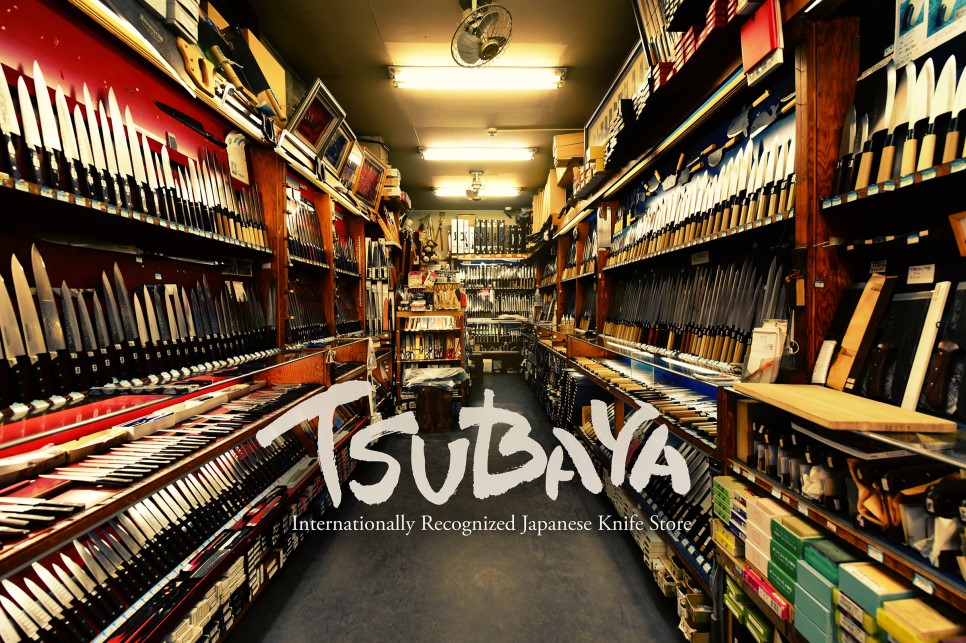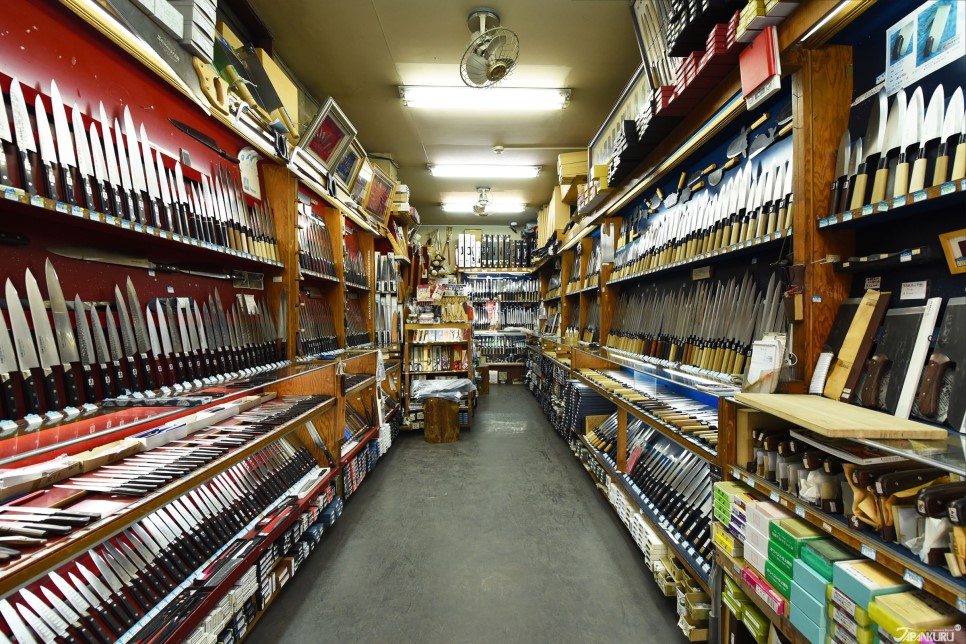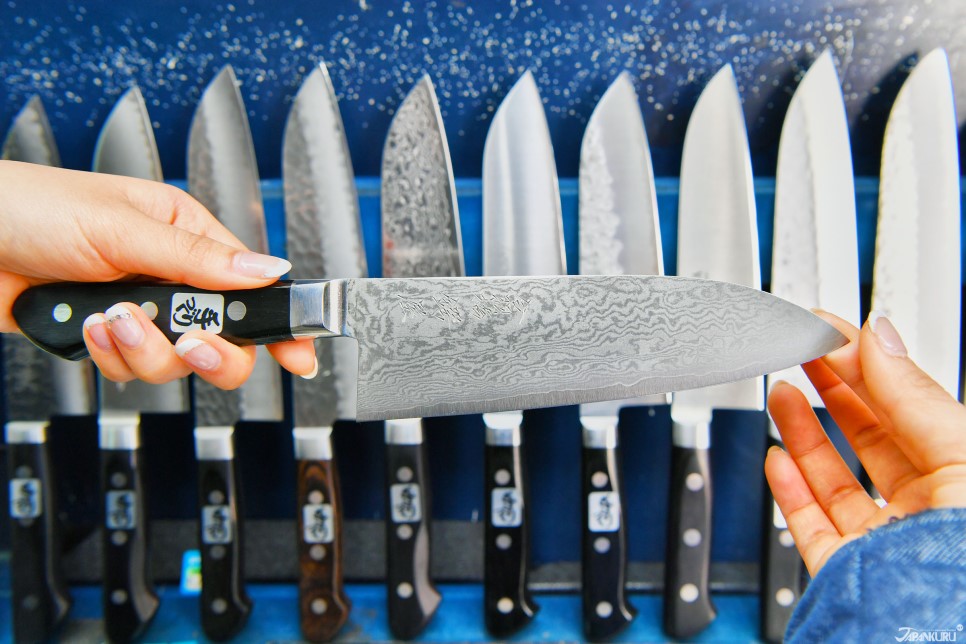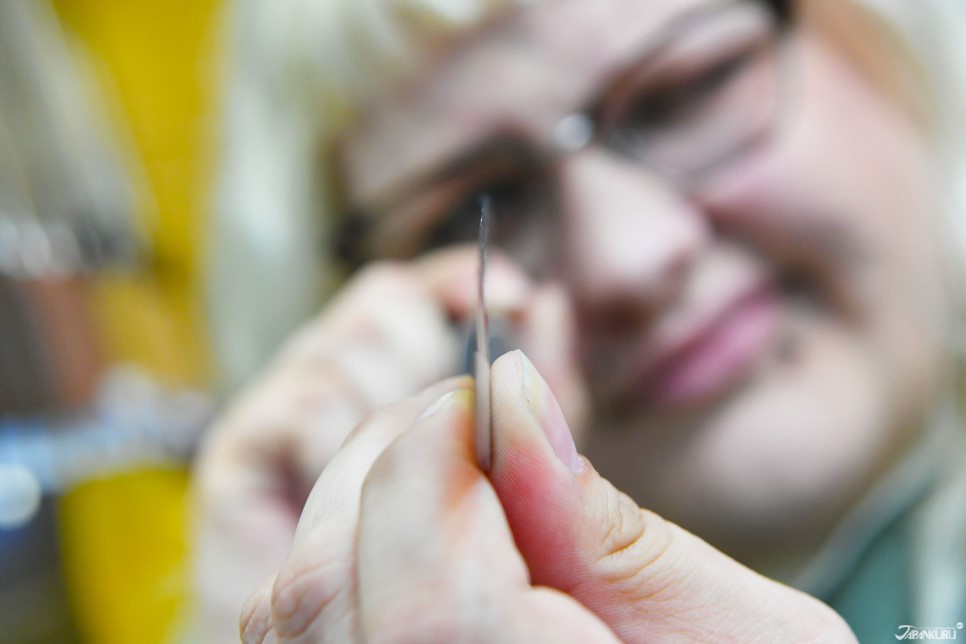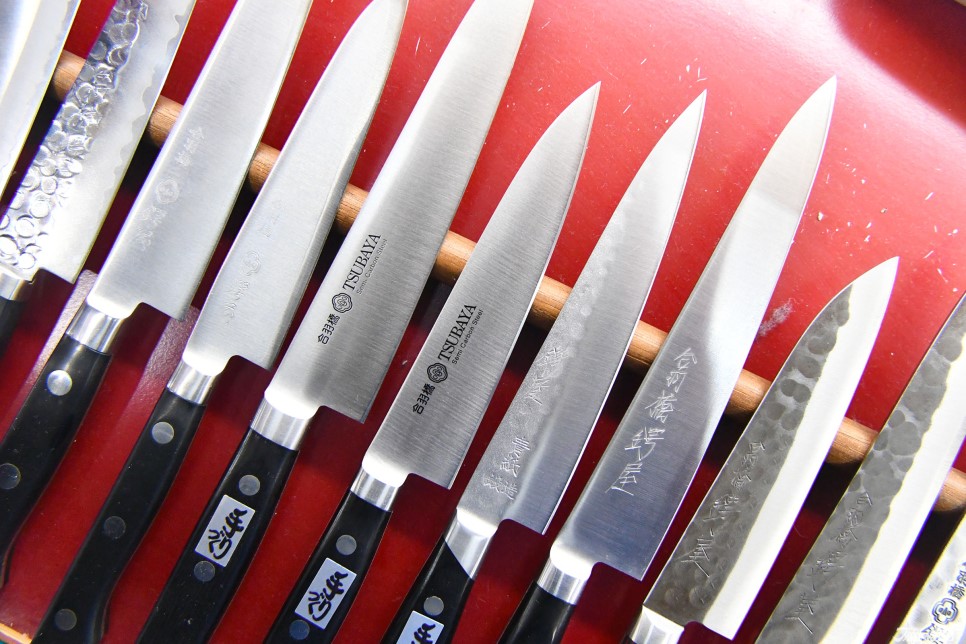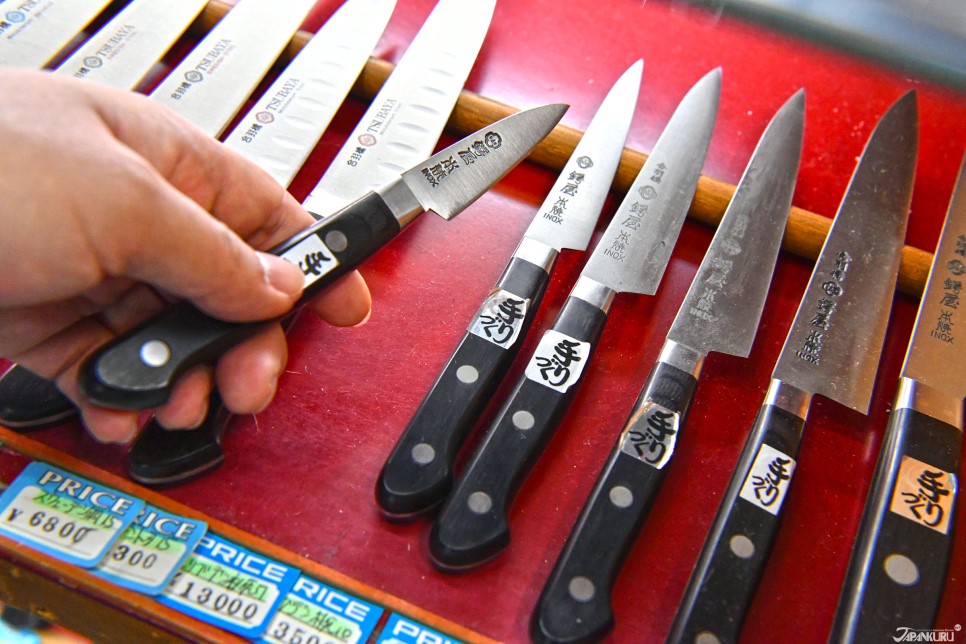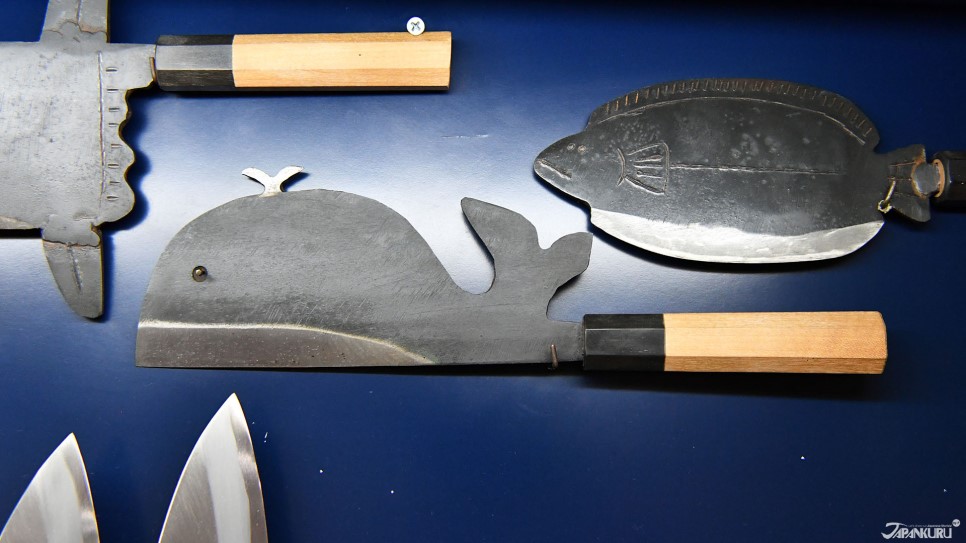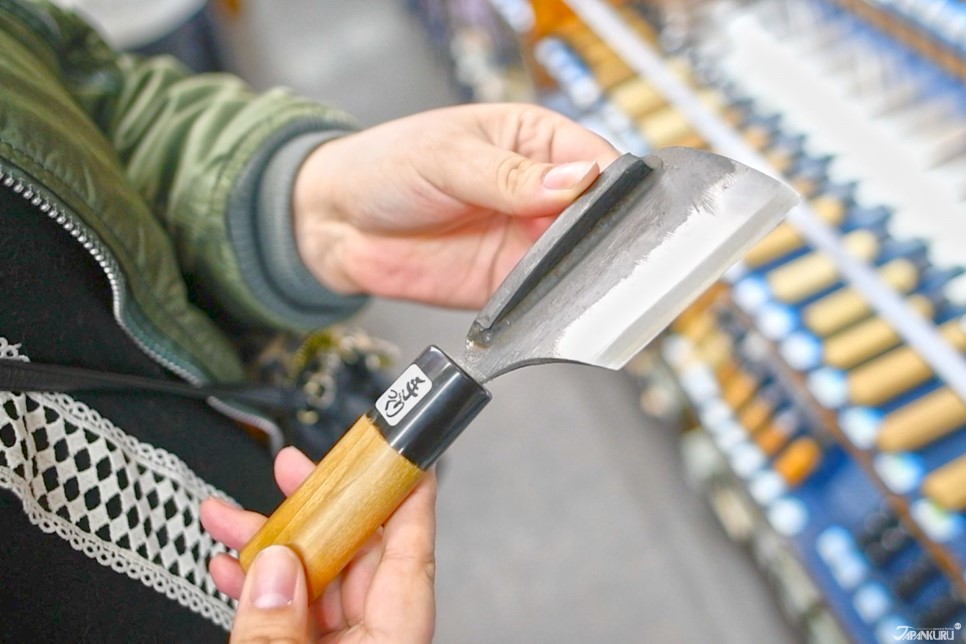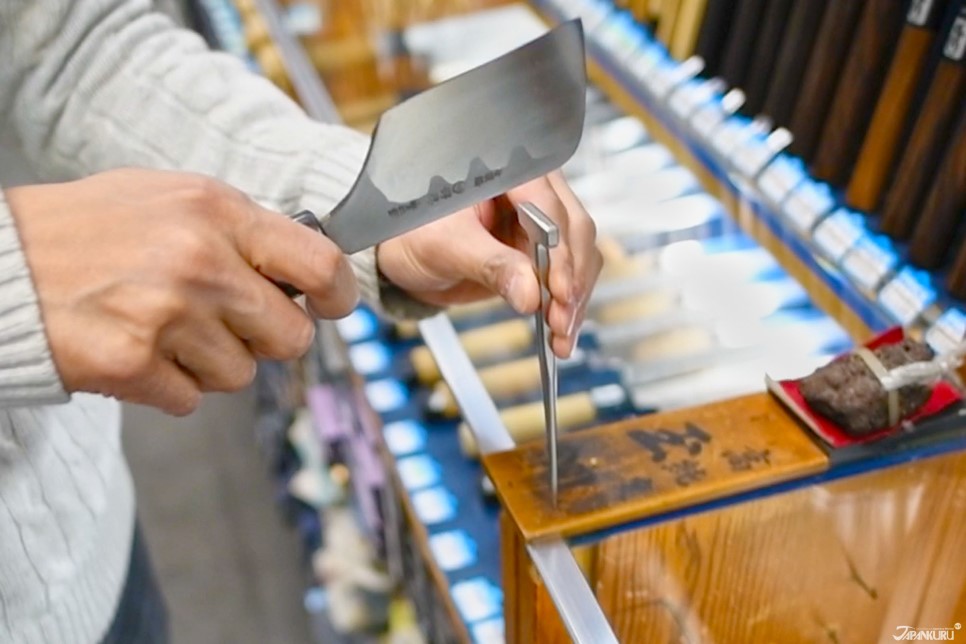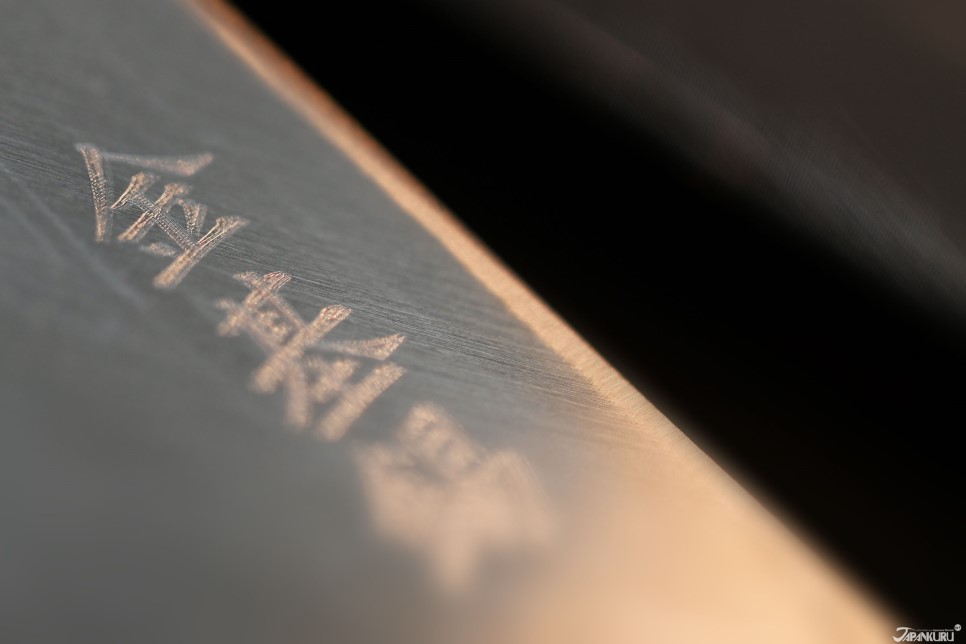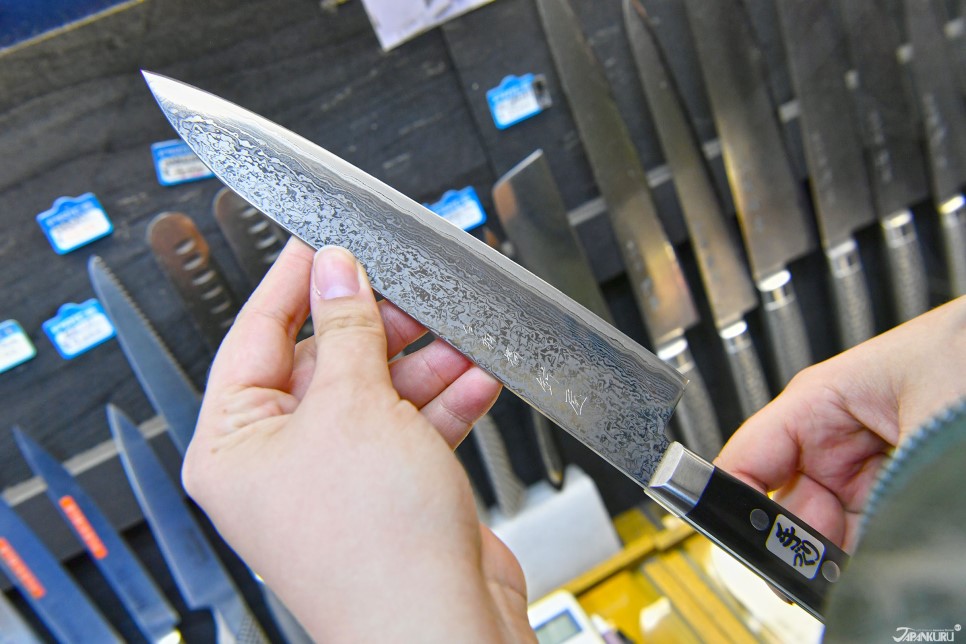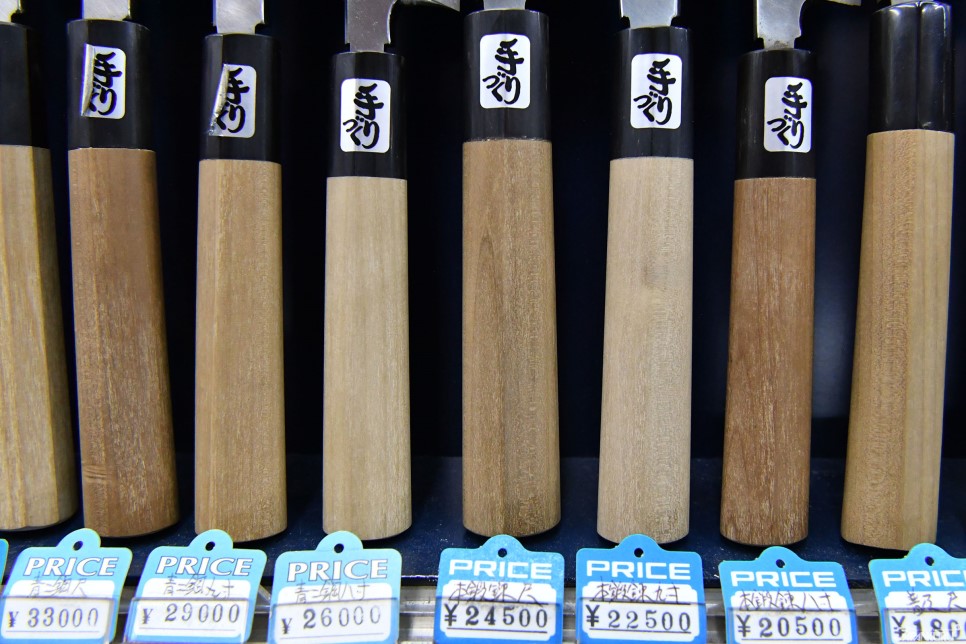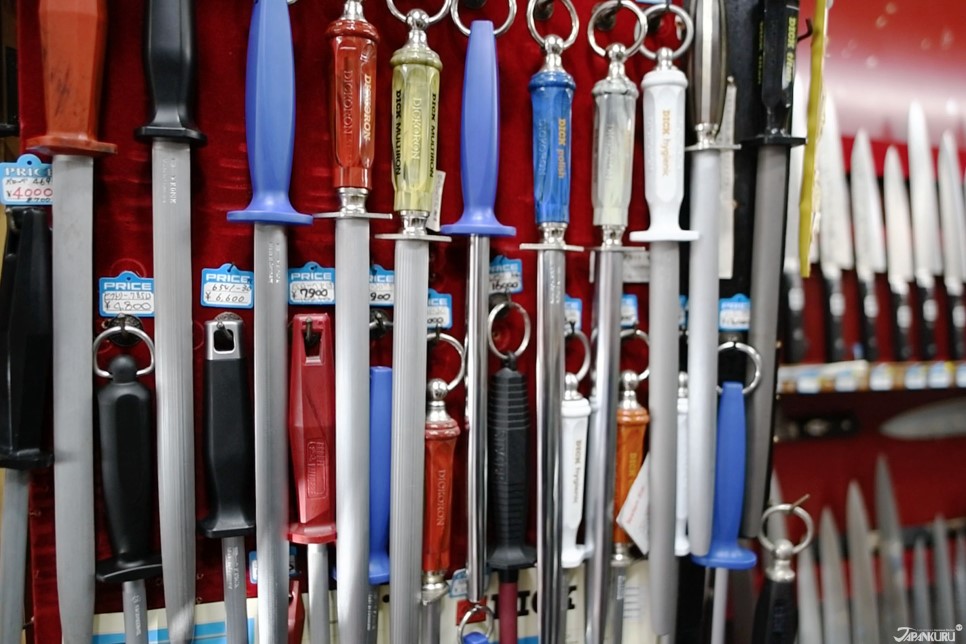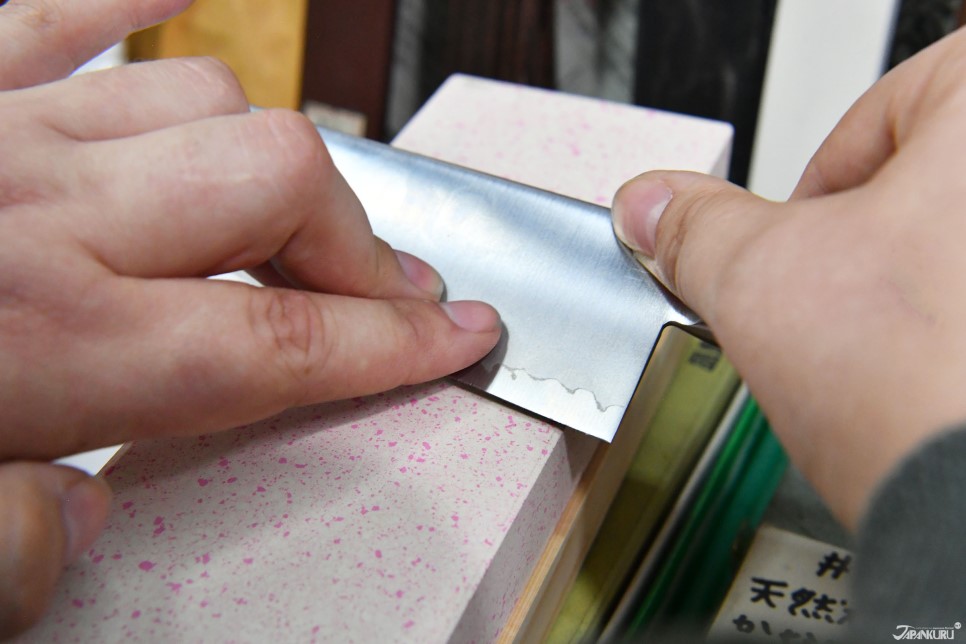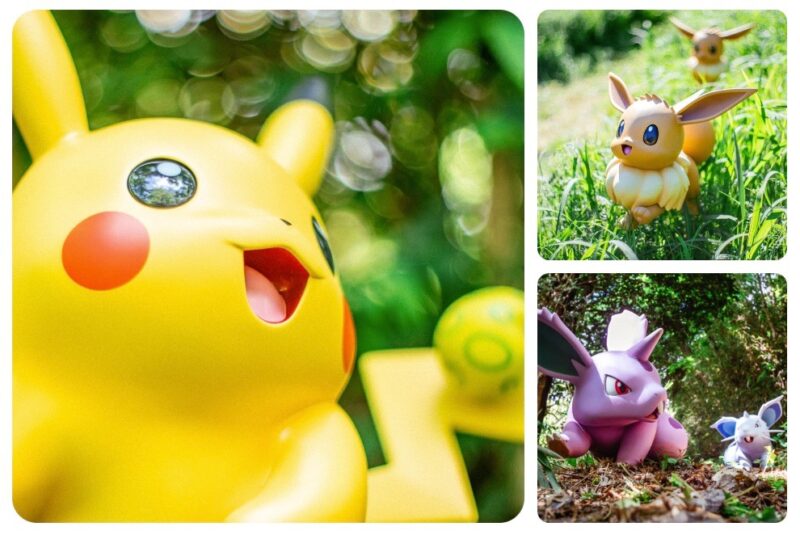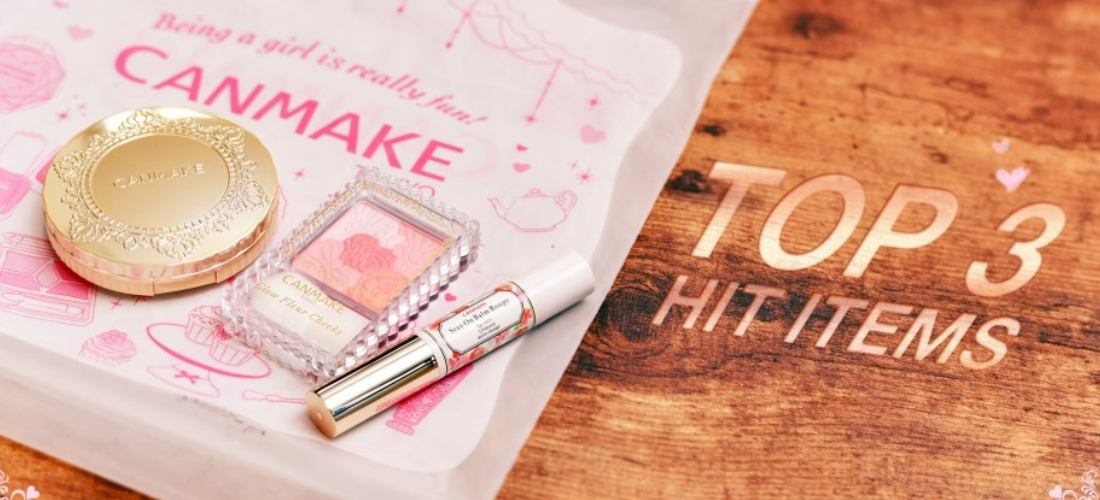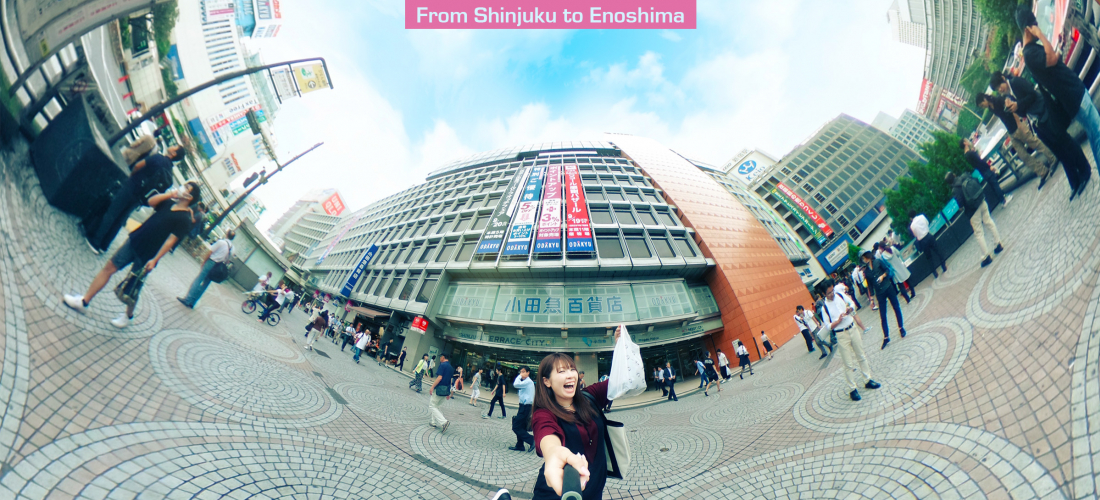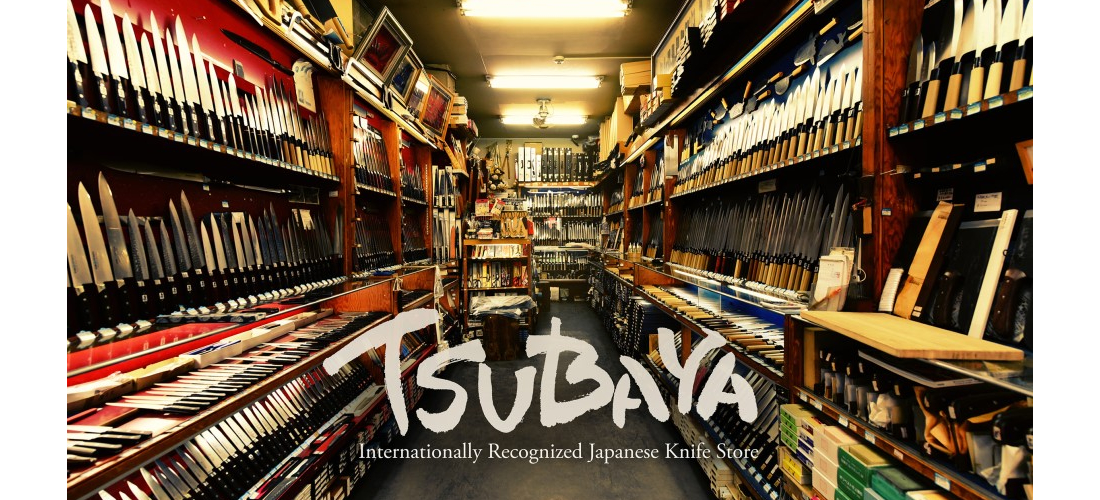
CONTENTS
ここは浅草から程近いかっぱ橋にある包丁屋さん!牛刀、柳刃、出刃包丁、筋引きなどの和包丁からペティナイフやブレッドナイフなどの洋包丁まで、専門性の高いものから一般的に見かけるものまで、包丁を幅広く取り扱う日本の包丁専門店つば屋へようこそ!
A Japanese Cooking Knife Specialty Store Known Around the World
Japanese knives are famous for their high quality, and so have become a popular item for foreign visitors to seek out during their trips. So we decided to dedicate an article to kitchen knives, including some useful information for those, professional chefs or not, looking to buy some knives during their trip to Japan.
Buyers from all over the world flock to the Kappabashi area of Asakusa, Tokyo, to purchase various kitchen and restaurant gear. Right in the middle of this is a store called Tsubaya, which specializes in kitchen knives made by Japanese craftsmen, and is perfect for anyone wondering where they can browse a great selection. This store has even made it onto TV in Japan!
Tsubaya opened in 1956, and has such a high reputation for kitchen knives all over Japan, many Japanese chefs here for their knives.
Japan’s Largest Cookware & Kitchenware Shopping Street: Kappabashi (かっぱ橋)
If you're looking for Japanese cookware and kitchenware, or things you never even knew you needed, Kappabashi is your place. Which is why Tsubaya is located there!
CUTLERY TSUBAYA (包丁専門つば屋)🗡
Address: 3-7-2, Nishi-Asakusa, Taito-ku, Tokyo
Access: 7 min. walk from Tawaramachi (田原町駅) on the Tokyo Metro Ginza Line OR 3 min. walk from TX Asakusa Station on the TSUKUBA EXPRESS
Phone: 03-3845-2005
E-Mail: info@tsubaya.co.jp
Official Website
Google Maps
1,000 Knives You Can Handle and Try Out
When you enter the store, you might feel like you've entered a museum of knives. The walls are covered with more than 1,000 cooking knives of all kinds. It's not really all that different from a museum collection— there are a lot of knives!
A look at the knife displays. All of these knives can be taken down from the shelves and held! Many knife stores won't let you hold the knives before purchase, but Tsubaya encourages it.
They explained that since a knife is such an important tool when cooking, they want their customers to be able to get a sense of each knife, and what it feels like.
Knives Classified According to their Applications
Since we're no cooking experts and don't know what makes each of the 1,000+ knives unique or special, we asked them to explain a few of the different kinds that Tsubaya has for sale.
We started with the most all-purpose kinds! These "universal knives" are about 15 to 20 cm long, and are what you often see in a typical home kitchen. These knives are some of the most popular items among Tsubaya's stock, since they're the most basic! They're generally divided into two varieties: Santoku & Gyuto knives.
Santoku (三徳)
Japanese-Style Universal Knives
The "sanko universal knife" is the most widely used knife among the many everyday knives. That means it will work well when cutting just about any food, including meat, fish, and vegetables.
The blade is made in a ratio of 5: 5, and it can cut at any angle without difficulty.
Gyuto (牛刀)
Western-Style Universal Knives
The "Kyūto Kotoku knife" is a kitchen knife widely used in Western countries, and is used mainly for cutting meat.
If you compare it to a santoku knife, you'll notice that it's longer in length and a fair amount narrower. It also has a point where the cross section of the knife edge is shifted by a ratio of 7: 3 or 8: 2, making it a good knife for cutting through hunks of meat, or tendons.
As a universal knife, it can certainly be used for all sorts of things, including vegetables or fish. But it's an especially good choice for those who cut through a lot of meat!
Bread Knives
Tsubaya sells a variety of bread knives as well, even if they're less of a Japanese tradition. Thanks to their cross sections, and their longer ~30 cm lengths, the knives are able to cut further without going back and forth too many times. This helps preserve the shape of the bread, instead of crushing it with too much pressure.
With more Japanese people baking in their homes in recent years, bread knives have become a popular item!
Petty Knives
These little knives originate from Japan, and are usually about 13 cm long. They're great for cutting fruit, and are even frequently used at patisseries! Since they're not particularly common, many patissiers come looking for them.
Unique Knives Only Available at Tsubaya
Fun and Creative Knives
This knife is packed with extremely practical knives, long blades, short blades, they can cut whatever food you throw at them. But that's not all they have!
Knives shaped like whales and blowfish are just some of the more silly options on display. A Chinese customer apparently once ordered a turtle-shaped knife!
Knives Just for Preparing Eel
This particular variety of knife is made specifically for preparing eel! The top of the blade has what looks like a hammer, which is used to hammer the large nail that is used to pin down the eel. They are slippery!
Make it Unique with a Custom Engraving!
If you want to make your knife truly the only one like it in the whole world, you can try out their engraving service. We tried it out by getting our friend's name engraved in kanji (Chinese characters.) Whatever message you want written onto your knife for the rest of its life, they use a dedicated machine at the back of the store to do it immediately, so you don't have to come back to pick it up!
Q & A for First-Time Visitors
Q. On my first visit, what should I buy?
A. We recommend a universal knife, or a petty knife. It's easier for beginner knife-users to use an all-purpose knife, especially since it can be used in the preparation of all kinds of ingredients. If you have a budget closer to 20,000 yen, we recommend purchasing a universal knife and a petty knife together, giving you more variety in knife size.
In addition, we recommend the "yanagiba" (柳刃), which is great for cutting raw fish!
Q. What's the difference between a wooden handle and a plastic handle?
A. The differences lie in both design and durability. Wooden handles have a strong sense of Japanese design, making them appealing to Western customers. Wood is easily discolored, so most Japanese customers prefer plastic handles. (All handles are replaceable, however.)
Q. How should I sharpen my knife?
A. The metal rods you often see in movies are kind of like first-aid, they're a quick fix when you want to use the knife immediately. For thorough sharpening, you have to use a sharpening stone, or togiishi (研ぎ石).
Q. Aren't all the knives the same, aside from size?
A. Aside from the more obvious size differences, the knives also vary in material and durability. They might all look similar at first glance, but the ratios involved in the blades, handles, and different parts' sizes are important. Some are also extra high quality!
For example, stainless steel doesn't have the same cutting force as pure iron, but it doesn't rust. So it's much easier to maintain.
Still Feeling Unsure About Japanese Knives?
Japanese cuisine is now popular around the world, and the huge variety of knives offered by Tsubaya includes a number that are suited specifically for preparing Japanese delicacies. These knives are perfect for any budding chefs you may know! And if you walk in and feel a little overwhelmed, don't worry! There are English-speaking staff, and they are happy to spend some time teaching you about the great variety of knives available, and helping you find the perfect knife to take home with you. (Just don't forget to put your precious new kitchen knife in your checked baggage! You don't want it getting confiscated by security.)
3-7-2, Nishi-Asakusa, Taito-ku, Tokyo
7 min walk from Tawaramachi (田原町駅) on the Tokyo Metro Ginza Line OR
3 min walk from TX Asakusa Station on the TSUKUBA EXPRESS
Phone: 03-3845-2005
E-Mail: info@tsubaya.co.jp
Google Maps
(If you're looking for a place to stay nearby, try here!)
Be sure to look out for more exciting articles every day at JAPANKURU! 🐶
Or add us on Instagram and Facebook to share your pictures of Japan. 💖🗾
⇩Learn More About Tsubaya in Our Video Below⇩
Details
NAME:CUTLERY TSUBAYA (包丁専門つば屋)
MAP
ACCESS:Asakusa Station
COMMENT
FEATURED MEDIA
VIEW MORE 
A New Tokyo Animal Destination: Relax & Learn About the World’s Animals in Japan
#pr #japankuru #anitouch #anitouchtokyodome #capybara #capybaracafe #animalcafe #tokyotrip #japantrip #카피바라 #애니터치 #아이와가볼만한곳 #도쿄여행 #가족여행 #東京旅遊 #東京親子景點 #日本動物互動體驗 #水豚泡澡 #東京巨蛋城 #เที่ยวญี่ปุ่น2025 #ที่เที่ยวครอบครัว #สวนสัตว์ในร่ม #TokyoDomeCity #anitouchtokyodome

Shohei Ohtani Collab Developed Products & Other Japanese Drugstore Recommendations From Kowa
#pr #japankuru
#kowa #syncronkowa #japanshopping #preworkout #postworkout #tokyoshopping #japantrip #일본쇼핑 #일본이온음료 #오타니 #오타니쇼헤이 #코와 #興和 #日本必買 #日本旅遊 #運動補充能量 #運動飲品 #ช้อปปิ้งญี่ปุ่น #เครื่องดื่มออกกำลังกาย #นักกีฬา #ผลิตภัณฑ์ญี่ปุ่น #อาหารเสริมญี่ปุ่น

도쿄 근교 당일치기 여행 추천! 작은 에도라 불리는 ‘가와고에’
세이부 ‘가와고에 패스(디지털)’ 하나면 편리하게 이동 + 가성비까지 완벽하게! 필름카메라 감성 가득한 레트로 거리 길거리 먹방부터 귀여움 끝판왕 핫플&포토 스폿까지 총집합!
Looking for day trips from Tokyo? Try Kawagoe, AKA Little Edo!
Use the SEIBU KAWAGOE PASS (Digital) for easy, affordable transportation!
Check out the historic streets of Kawagoe for some great street food and plenty of picturesque retro photo ops.
#pr #japankuru #도쿄근교여행 #가와고에 #가와고에패스 #세이부패스 #기모노체험 #가와고에여행 #도쿄여행코스 #도쿄근교당일치기 #세이부가와고에패스
#tokyotrip #kawagoe #tokyodaytrip #seibukawagoepass #kimono #japantrip

Hirakata Park, Osaka: Enjoy the Classic Japanese Theme Park Experience!
#pr #japankuru #hirakatapark #amusementpark #japantrip #osakatrip #familytrip #rollercoaster #retrôvibes #枚方公園 #大阪旅遊 #關西私房景點 #日本親子旅行 #日本遊樂園 #木造雲霄飛車 #히라카타파크 #สวนสนุกฮิราคาตะพาร์ค

🍵Love Matcha? Upgrade Your Matcha Experience With Tsujiri!
・160년 전통 일본 말차 브랜드 츠지리에서 말차 덕후들이 픽한 인기템만 골라봤어요
・抹茶控的天堂!甜點、餅乾、飲品一次滿足,連伴手禮都幫你列好清單了
・ส่องมัทฉะสุดฮิต พร้อมพาเที่ยวร้านดังในอุจิ เกียวโต
#pr #japankuru #matcha #matchalover #uji #kyoto #japantrip #ujimatcha #matchalatte #matchasweets #tsujiri #말차 #말차덕후 #츠지리 #교토여행 #말차라떼 #辻利抹茶 #抹茶控 #日本抹茶 #宇治 #宇治抹茶 #日本伴手禮 #抹茶拿鐵 #抹茶甜點 #มัทฉะ #ของฝากญี่ปุ่น #ชาเขียวญี่ปุ่น #ซึจิริ #เกียวโต

・What Is Nenaito? And How Does This Sleep Care Supplement Work?
・你的睡眠保健品——認識「睡眠茶氨酸錠」
・수면 케어 서플리먼트 ‘네나이토’란?
・ผลิตภัณฑ์เสริมอาหารดูแลการนอน “Nenaito(ネナイト)” คืออะไร?
#pr #japankuru #sleepcare #japanshopping #nenaito #sleepsupplement #asahi #睡眠茶氨酸錠 #睡眠保健 #朝日 #l茶胺酸 #日本藥妝 #日本必買 #일본쇼핑 #수면 #건강하자 #네나이토 #일본영양제 #อาหารเสริมญี่ปุ่น #ช้อปปิ้งญี่ปุ่น #ร้านขายยาญี่ปุ่น #ดูแลตัวเองก่อนนอน #อาซาฮิ

Japanese Drugstore Must-Buys! Essential Items from Hisamitsu® Pharmaceutical
#PR #japankuru #hisamitsu #salonpas #feitas #hisamitsupharmaceutical #japanshopping #tokyoshopping #traveltips #japanhaul #japantrip #japantravel

Whether you grew up with Dragon Ball or you just fell in love with Dragon Ball DAIMA, you'll like the newest JINS collab. Shop this limited-edition Dragon Ball accessory collection to find some of the best Dragon Ball merchandise in Japan!
>> Find out more at Japankuru.com! (link in bio)
#japankuru #dragonball #dragonballdaima #animecollab #japanshopping #jins #japaneseglasses #japantravel #animemerch #pr

This month, Japankuru teamed up with @official_korekoko to invite three influencers (originally from Thailand, China, and Taiwan) on a trip to Yokohama. Check out the article (in Chinese) on Japankuru.com for all of their travel tips and photography hints - and look forward to more cool collaborations coming soon!
【橫濱夜散策 x 教你怎麼拍出網美照 📸✨】
每次來日本玩,是不是都會先找旅日網紅的推薦清單?
這次,我們邀請擁有日本豐富旅遊經驗的🇹🇭泰國、🇨🇳中國、🇹🇼台灣網紅,帶你走進夜晚的橫濱!從玩樂路線到拍照技巧,教你怎麼拍出最美的夜景照。那些熟悉的景點,換個視角說不定會有新發現~快跟他們一起出發吧!
#japankuru #橫濱紅磚倉庫 #汽車道 #中華街 #yokohama #japankuru #橫濱紅磚倉庫 #汽車道 #中華街 #yokohama #yokohamaredbrickwarehouse #yokohamachinatown

If you’re a fan of Vivienne Westwood's Japanese designs, and you’re looking forward to shopping in Harajuku this summer, we’ve got important news for you. Vivienne Westwood RED LABEL Laforet Harajuku is now closed for renovations - but the grand reopening is scheduled for July!
>> Find out more at Japankuru.com! (link in bio)
#japankuru #viviennewestwood #harajuku #omotesando #viviennewestwoodredlabel #viviennewestwoodjapan #비비안웨스트우드 #오모테산도 #하라주쿠 #日本購物 #薇薇安魏斯伍德 #日本時尚 #原宿 #表參道 #japantrip #japanshopping #pr

Ready to see TeamLab in Kyoto!? At TeamLab Biovortex Kyoto, the collective is taking their acclaimed immersive art and bringing it to Japan's ancient capital. We can't wait to see it for ourselves this autumn!
>> Find out more at Japankuru.com! (link in bio)
#japankuru #teamlab #teamlabbiovortex #kyoto #kyototrip #japantravel #artnews
Photos courtesy of teamLab, Exhibition view of teamLab Biovortex Kyoto, 2025, Kyoto ® teamLab, courtesy Pace Gallery

Japanese Makeup Shopping • A Trip to Kamakura & Enoshima With Canmake’s Cool-Toned Summer Makeup
#pr #canmake #enoshima #enoden #에노시마 #캔메이크 #japanesemakeup #japanesecosmetics

⚔️The Robot Restaurant is gone, but the Samurai Restaurant is here to take its place. Check it out, and don't forget your coupon!
🍣신주쿠의 명소 로봇 레스토랑이 사무라이 레스토랑으로 부활! 절찬 쿠폰 발급중
💃18歲以上才能入場的歌舞秀,和你想的不一樣!拿好優惠券去看看~
#tokyo #shinjuku #samurairestaurant #robotrestaurant #tokyotrip #도쿄여행 #신주쿠 #사무라이레스토랑 #이색체험 #할인이벤트 #歌舞伎町 #東京景點 #武士餐廳 #日本表演 #日本文化體驗 #japankuru #japantrip #japantravel #japanlovers #japan_of_insta

Japanese appliance & electronics shopping with our KOJIMA x BicCamera coupon!
用JAPANKURU的KOJIMA x BicCamera優惠券買這些正好❤️
코지마 x 빅 카메라 쿠폰으로 일본 가전 제품 쇼핑하기
#pr #japankuru #japanshopping #kojima #biccamera #japaneseskincare #yaman #dji #osmopocket3 #skincaredevice #日本購物 #美容儀 #相機 #雅萌 #日本家電 #일본여행 #면세 #여행꿀팁 #일본쇼핑리스트 #쿠폰 #일본쇼핑 #일본브랜드 #할인 #코지마 #빅카메라 #japankurucoupon
MAP OF JAPAN
SEARCH BY REGION

LATEST
VIEW MOREEVENT CALENDAR
VIEW MORE





